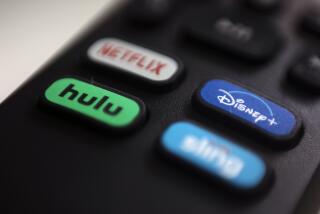HBO Now stand-alone service shakes up TV industry
- Share via
The Apple Watch stole the spotlight at the tech company’s media extravaganza Monday. But it was an announcement at the same event, made by HBO, that marks a true turning point.
HBO Chief Executive Richard Plepler introduced HBO Now, a $14.99-a-month service set to launch next month on Apple devices, representing the first time the premium cable network will be offered directly to customers — a tectonic shift for the television industry.
“This is the moment,” said James McQuivey, an analyst with Forrester Research. “We’ll look back and say this was when the game was fundamentally changed.”
Consumers who complained they’d drop their cable if only they could get HBO now have their chance. Along with sports, HBO long has been considered part of the glue that holds the pay-TV bundles together. Until now, viewers couldn’t get immediate access to HBO programming such as “Game of Thrones,” “Girls,” “True Detective” and a vast library of Hollywood movies without signing up for a package of pay-TV channels that typically costs more than $100 a month. Soon they can.
“This is a transformative moment for HBO,” Plepler said from the stage of a San Francisco theater, introduced by Apple CEO Tim Cook.
Driven by video alternatives available on computers and smartphones, consumers are demanding more options and more personal choice for their entertainment. And the television industry — after years of resistance — is beginning to bend to those demands.
Because HBO has some of the most sought-after programs on television, its decision to offer a stand-alone service is expected to accelerate the dismantling of bundled pay-TV channel packages in which households pay for a wide range of programming, even for channels they never watch. The move also is expected to prompt pay-TV distributors to offer smaller and less-expensive packages to consumers.
“This action by HBO will certainly encourage cord-cutting,” McQuivey said, referring to the process of ditching cable and its monthly bill for online video alternatives.
Monday’s deal gives Apple a three-month period to exclusively offer HBO Now on its iPhones, iPads or Apple TVs. After that, HBO is expected to offer the service to users of a wide variety of other devices. The window gives Apple TV bragging rights and marketing attention as it competes against video streaming alternatives such as Google’s Chromecast, Amazon’s Fire TV and Roku.
On Monday, Cook said the Apple TV prices would drop from $99 to $69, closer to competitors’ prices.
HBO first signaled its plans to offer a stand-alone streaming service last fall. Plepler’s eye was on the roughly 10 million homes in the U.S. with high-speed Internet service but not a pay-TV subscription, a market segment that skews young.
Just a few years ago, Plepler was part of the crowd of TV industry executives that resisted change in the face of successful streaming services Netflix, Hulu and Amazon.com.
He joked that there were “4 billion reasons” to adhere to HBO’s long-standing business model to partner only with pay-TV companies rather than offer its service directly to consumers. HBO generates roughly $4 billion in revenue each year through its affiliation deals with pay-TV companies, including Time Warner Cable, Comcast Corp., DirecTV and Dish Network.
“You are seeing technology companies take advantage of the frustration that exists with the existing pay-TV system,” said Steve Beck, founder of cg42, a management consultant firm. “For years, cable TV was the only way that consumers could access the content they wanted to watch. They subscribed not because they loved their cable TV provider but because it was the only way to see the content. But now there are alternatives.”
The deal with Apple had been in the works for nearly a year.
HBO saw Apple as a natural partner: 60% of the hits on its HBO Go app, offered to current cable subscribers, came from Apple devices, Plepler said. He also expects to benefit from Apple’s considerable marketing muscle to promote HBO Now.
HBO is not alone in its migration to Internet delivery. Several other established networks — including CBS, the Tennis Channel and children’s channel Nickelodeon — have introduced so-called over-the-top stand-alone services during the past year. Satellite TV giant Dish Network in January unveiled its Sling TV, a package of TV channels including ESPN and TBS, which also is delivered over the Internet for $20 a month.
Last week, NBC acknowledged that it was working on a stand-alone comedy channel that will likely feature such shows as “The Tonight Show With Jimmy Fallon.” Nearly 70% of the audience for Fallon’s show already watch clips online rather than tune in at 11:35 p.m. when the show runs on NBC.
HBO is pricing the service — at $14.99 a month — considerably higher than the fees charged by competing streaming services such as Netflix and Hulu Plus. One reason: HBO wants to keep intact its long-standing relationships with pay-TV operators.
HBO already costs pay-TV customers about $15 a month in addition to their basic plans. About 33 million subscribers in the U.S. currently receive the service through their cable or satellite TV companies. By offering its new HBO Now stand-alone service at roughly the same cost, people who already subscribe to pay-TV and HBO won’t have a financial incentive to suddenly cancel their subscriptions, the theory goes.
“This just proves that the future is not binary, it’s multi-lateral,” Plepler said later in an interview. “We are going to continue to have big partnerships with our current providers as well as big partnerships with technology companies like Apple. And all of this will benefit consumers who will have access to our programming.”
Cable and satellite TV providers, and rival streaming service Netflix, declined to comment.
Times staff writer Paresh Dave contributed to this report.
ALSO:
Hands on with Apple’s new MacBook
Apple Watch could become latest must-have fashion accessory
More to Read
From the Oscars to the Emmys.
Get the Envelope newsletter for exclusive awards season coverage, behind-the-scenes stories from the Envelope podcast and columnist Glenn Whipp’s must-read analysis.
You may occasionally receive promotional content from the Los Angeles Times.










